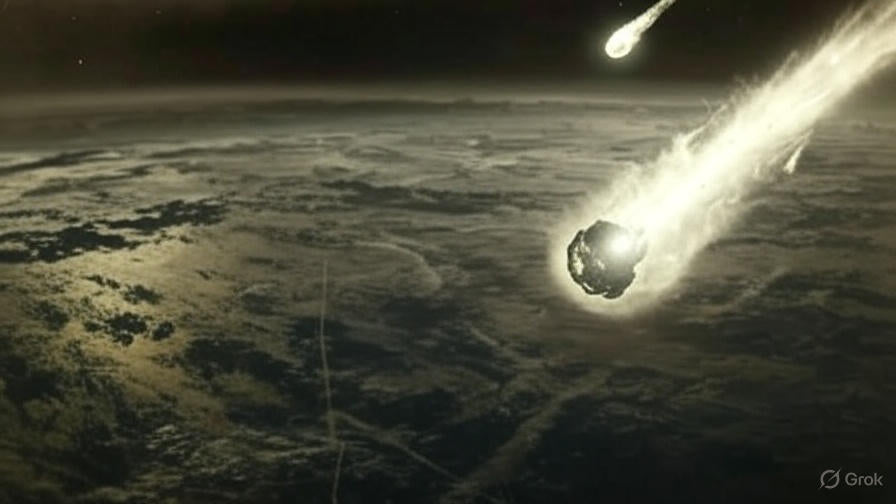NASA’s Asteroid Plan: Nukes to Protect the Moon in 2032
Introduction
On September 25, 2025, a tweet from Dexerto captured global attention, revealing that NASA scientists are exploring the possibility of using nuclear explosives to prevent an asteroid from colliding with the Moon in 2032. Accompanied by a grayscale asteroid image and the iconic NASA logo, this announcement has raised both curiosity and concern worldwide. This article explores the asteroid threat, the proposed nuclear intervention, and the scientific and ethical considerations involved.
The Asteroid: 2024 YR4
The asteroid, 2024 YR4, was discovered in December 2024 and measures approximately 55 meters wide—significant enough to be considered a serious celestial threat if it were headed toward Earth. Current projections indicate a 4% chance of collision with the Moon on December 22, 2032.
An impact could create a crater about 1 kilometer wide and eject millions of kilograms of lunar debris into space. This debris could enter Earth’s orbit, potentially affecting satellites, the International Space Station, and other space operations.
NASA scientists are considering firing nukes at an asteroid that could collide with the Moon in 2032 pic.twitter.com/XptzBE8Kcv
— Dexerto (@Dexerto) September 25, 2025
NASA’s Proposed Nuclear Solution
A September 2025 research paper by an international team, including NASA-affiliated scientists, outlines using low-yield nuclear detonations to alter the asteroid’s trajectory between 2029 and 2031.
The method involves ablating the asteroid’s surface, generating a thrust that nudges it off course. Traditional techniques, such as kinetic impactors, may not be viable due to the short timeline.
Potential Risks:
- Fragmentation of the asteroid, producing multiple hazardous pieces.
- Lunar debris scattering into Earth’s orbit, increasing collision risks for satellites.
Public Reactions and Misconceptions
- Memes and jokes referencing movies and video games.
- Serious debate on alternative methods, like gravitational nudges.
- Clarification that this is not an official NASA mission, but a theoretical proposal from a research paper.
Scientific and Ethical Considerations
Using nuclear weapons in space is both technically complex and ethically sensitive:
- Scientific: Requires precise trajectory calculations to prevent unintended consequences.
- Ethical: Must follow international treaties like the Outer Space Treaty, which restricts nuclear weapons in space.
Past missions like NASA’s DART (2022) have successfully demonstrated asteroid deflection using kinetic impact, providing a baseline for such studies.
FAQs
Q1: Is NASA actually planning to use nukes on an asteroid?
A1: No, this is a theoretical proposal from a research paper by NASA-affiliated scientists, not an official mission.
Q2: What is the probability of 2024 YR4 hitting the Moon?
A2: Current estimates indicate a 4% chance of impact in 2032.
Q3: Could this affect Earth?
A3: Debris from a lunar impact could enter Earth’s orbit, posing risks to satellites and the ISS, but direct Earth impact is unlikely.
Q4: Are there alternative asteroid deflection methods?
A4: Yes, including kinetic impactors, gravitational tugs, and laser ablation. The nuclear method is considered due to limited time.
Conclusion
NASA’s asteroid nuclear proposal highlights humanity’s evolving planetary defense strategies. While the 4% probability keeps the scenario unlikely, the plan demonstrates scientific ingenuity and preparedness for cosmic threats. Whether theoretical or practical in the future, it emphasizes the importance of international collaboration, ethics, and precision science in space exploration.
Opinion
From a neutral standpoint, this proposal is a fascinating illustration of how modern science tackles extreme scenarios. Using nuclear devices in space is unprecedented, raising questions about responsibility, risk management, and long-term implications. While the technical feasibility may be achievable, the ethical, legal, and political challenges are immense. International consensus, stringent simulations, and contingency planning would be critical.
Ultimately, the study of asteroid 2024 YR4 underscores humanity’s dual role as explorer and protector in space. Preparing for low-probability yet high-impact events reflects not fear but prudence—showing that even distant threats can drive innovation, debate, and global cooperation. This approach may well set a precedent for managing future space hazards, blending technical ingenuity with global responsibility.


0 comments